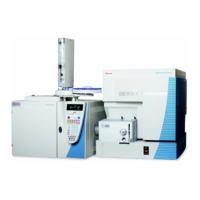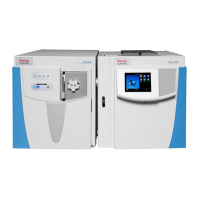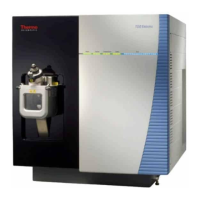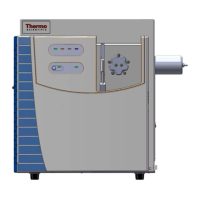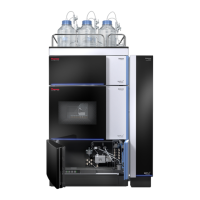3
Vacuum System
Inlet Gases Hardware
26 TSQ Endura and TSQ Quantiva Hardware Manual Thermo Scientific
Nitrogen Gas Valves
The data system controls the valves that regulate the nitrogen pressure (see “Checking the Gas
Supplies” on page 58). You can set the gas flow rates in the Ion Source pane of the Tune
application.
Dry nitrogen gas (690 ±140 kPa [100 ±20 psi], 99% purity) enters the left side of the mass
spectrometer through a 1/4 in. port. The valves for the sheath, auxiliary, and sweep gases
control the flow of dry nitrogen gas into the API source (Figure 9). Sheath gas is the
inner-coaxial nitrogen gas that helps nebulize the sample solution into a fine mist as the
solution exits the API spray insert nozzle. Auxiliary gas is the outer-coaxial nitrogen gas that
helps the sheath gas in the nebulization and evaporation of the sample solution by focusing
the vapor plume and lowering the humidity in the API source. Sweep gas is the off-axis
nitrogen gas that flows out from behind the optional ion sweep cone to aid in solvent
declustering and adduct reduction. The optional ion sweep cone has an inlet for the sweep
gas.
Argon Gas Valves
The data system controls the valves that regulate the argon gas pressure (see Checking the Gas
Supplies). You can set the collision gas pressure (CID gas) in the Tune application.
Argon gas (135 ±70 kPa [20 ±10 psi], 99.995% minimum purity) enters the left side of the
mass spectrometer through a 1/8 in. port. The valves for the collision gas control the flow of
argon gas into and out of the Q2 collision cell. When activated, a solenoid valve shuts off the
argon gas flow to the cell.
Vent Valve
The solenoid-operated vent valve allows the vacuum manifold to be vented with filtered air.
The vent valve on the vacuum manifold is closed when the solenoid is energized.
The vacuum manifold vents when the mass spectrometer no longer receives external power, as
with a power failure or when you turn off the main power switch. Power is briefly provided to
the vent valve after losing external power to protect against the accidental loss of power. When
power to the vent valve solenoid shuts off for more than a very brief period of time, the vent
valve opens and the manifold vents air.

